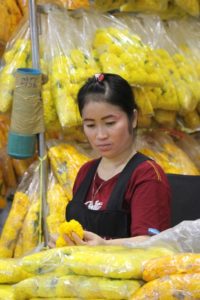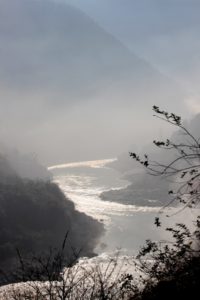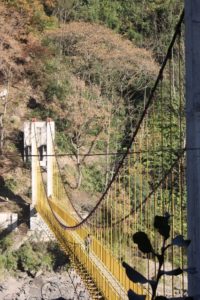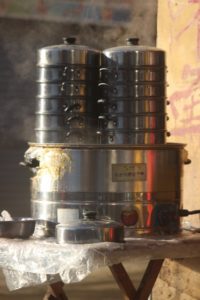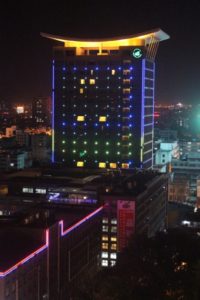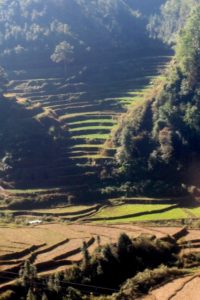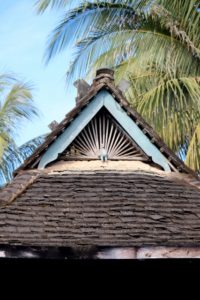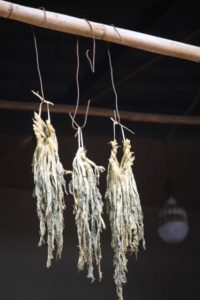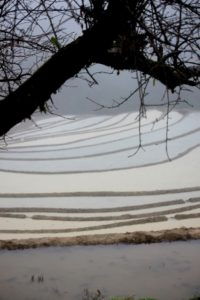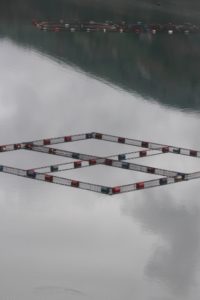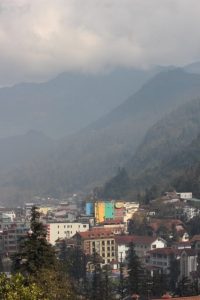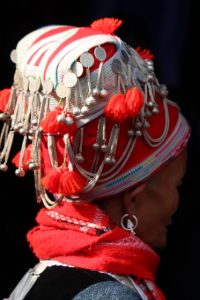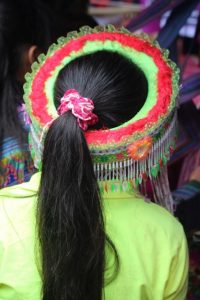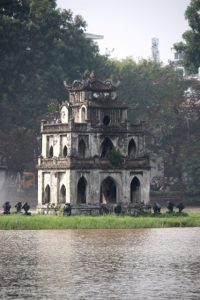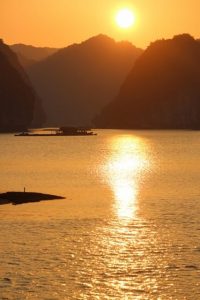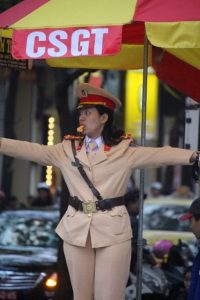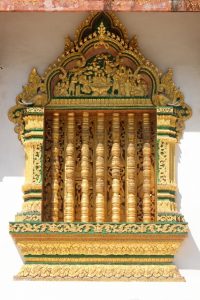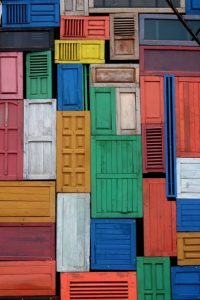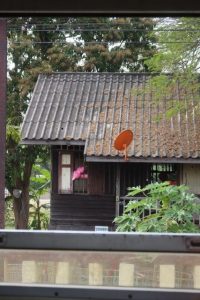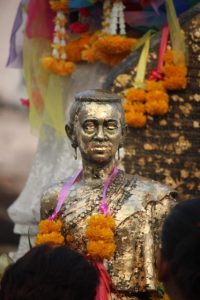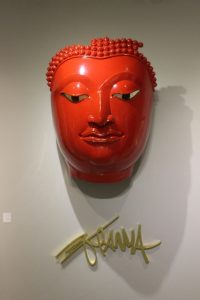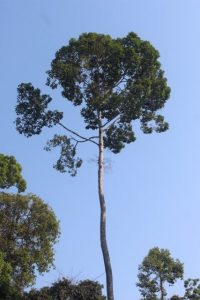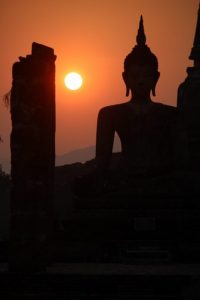At the end of 2017 we left for a ten weeks’ journey, from Southern China and Northern Vietnam to Laos and Thailand, essentially tying up a few loose end left from previous trips. We visited the Nu River and Xishuangbanna in Yunnan, the tribal area in Vietnam as well as Halong Bay, the Plain of Jars in Laos, and Isaan and the ancient capitals in Thailand, amongst other things, before we headed back home at the end of February 2018. Below is the travelogue we kept during the trip.
01. the return plan: Never return to a place where you have travelled, or lived, before! It can only disappoint, because it won’t match your expectations based on the good experiences of the past (and if you have had bad experiences, you wouldn’t dream of going back anyhow).
And yet, this is exactly what we are going to do.
02. Bangkok: A comfortable place to start our South East Asia journey, with as a bonus some river views and a Christmas atmosphere.
The contrast couldn’t be bigger. Back home it had been snowing, but the day we left the weather got better: it was pouring down with rain, still bitterly cold. When we landed in Bangkok, it was also a bit chilly, but that was from the air conditioner in the airport. Outside, it was a pleasant 30 oC, sunny and humid.Bangkok is always a good start for a trip in South East Asia.
03. the journey: The journey from Bangkok via Kunming to the start of our next travel target, the Nu River, was actually a very smooth one, but the reconnection with China after 20 years does trigger some observations.
The part I was most anxious about – the stretch of our journey where various pre-arranged things could go wrong – actually passed very smoothly. The plan, all booked ahead, was to fly to Kunming in Yunnan, overnight at a hotel near the airport, and continue the next morning by plane to Baoshan. Here we were to pick up a bus to Liuku, at the start of the Nujiang gorge, the river we were going to follow upstream for a few days.
We had booked our Kunming ticket on ominously-called Lucky Air…
04. the Nujiang Valley (1): The Nujiang Valley, the valley of the Nu River, proves that remote does not necessarily means undeveloped.
In every reference, guide book or internet site, the Nujiang Valley is described as one of the remotest parts of Yunnan. Significantly, in none of our 20-year old tourist guides the place was even mentioned (perhaps it was in any case off-limits for tourists at the time). Spectacular scenery is provided by the steep mountain slopes that encroach on the fast-flowing river. All along, minority villages are clinging to the valley wall, often impossibly high up the slopes. All this creates, at least for me, expectations of an authentic, back-to-the-last-century experience, little wooden houses, colourfully dressed people. Picturesque. So we were going to travel all the way to Bingzhongluo, at the very end of the valley – or the beginning, whichever way you look at it, in any case the furthest access point by road -, not to miss any of this.
05. the Nujiang Valley (2): A journey up the Nujiang Valley is a mixed experience, natural beauty in the shadow of a traffic chaos.
We move in stages. The two towns identified as potential stop-overs, ‘two-street’ Fugong and ‘one-street’ Gongshan, as the 2017 version of a reputable travel guide calls them, are, according to our various sources, including local bus drivers, no more than 3-4 hours drive apart, and from Liuku to Fugong is a similar distance. Overseeable.
Yet, a small problem arises in Liuku’s bus station…
06. Bingzhongluo: Touristic Bingzhongluo lacks a bit of services, especially for non-Mandarin speakers, but does offer beautiful surroundings.
More than any other place we have been so far on this trip, one-street Bingzhongluo lives from tourism. Or so it seems, because the only one street is lined with hotels and youth hostels, as well as an inordinate number of restaurants for such a small village.
And yet, for non-, or at least for limited-Mandarin speakers, it was difficult to gain any relevant information. We planned to stay a couple of days here, to do some mild trekking further along the river, and perhaps to a few ‘ethnic’ villages, but we could not get hold of any for us intelligible maps.
07. Baoshan: Modern, developed Baoshan still has its charms, hidden behind the avenues and in fringe neighbourhoods.
Baoshan is one of those Chinese cities that, well, is just like so many other Chinese cities, uniform, featureless, efficient. We had initially included it in our itinerary because apparently the centre still has many original wooden houses, but then dropped it for something else, only to reinstate it again to have a day’s rest between bus rides. And to treat ourselves to a nice and comfortable hotel.
08. Tengchong: Tengchong’s centre is completely being rebuilt; yet, there is are still a few traces of old China around.
Tengchong is two hour’s away from Baoshan, along a spectacular new motorway through the mountains. Another one of those one-in-a-hundred Chinese cities, perhaps? Maybe, but Tengchong looks to be developed even more aggressively than your average Chinese city, maybe on account of its tourist potential– more about that later. The entire centre of town is in ruins, everything older than, say, 20 years is being pulled down to make place for a giant development, with apartments, malls, fancy shopping areas and a park. Or at least, that is what the ‘artist impressions’, that have been posted on the fences that surround the building site, seem to promise. No lack of ambition here! And no lack of dust, no lack of construction-related noise! And hardly any trace left of those original wooden houses that were promised by that 20 year old guidebook.
09. the Tengchong tourist spots: Of the various tourist spots we visited around Tengchong, like Heshun, most were underwhelming; the war cemetery was impressive, though, for a variety of reasons.
Heshun is a ‘beautiful old village’, ‘very quiet and slow-paced’, and ‘rustic’ (this is from a recent website entry, not my 20 year old travel guide), 5 km outside town. Apparently, half of the houses are owned by Overseas Chinese, who are planning to return here to retire. Good luck to them! They probably don’t have to pay an entry fee, like we had, but will still need to wrangle their way through the thousands of tourists that visit this place, who stay in one of the many fancy boutique guest houses, and shop ‘till they drop in the hundreds of tourist shops that line the streets. And we weren’t even in season.
10. the marathon: On the challenges of moving from A to B in China, and those of communication to achieve that.
Having seen enough of Tengchong and Baoshan, and getting fed up with the cold – beautiful blue skies all along, but evening temperatures dropping to 4-5 oC, and mornings only slowly warming up – we were ready for our next destination.
We were heading to Xishuangbanna, China’s most South-East Asian county, still part of Yunnan. Xishuangbanna borders Laos and Myanmar, and is populated by various ethnic minority groups that have more in common with their brethren across the various borders than with the Han Chinese. The capital of this area is called Jinghong, a good starting point for our Xishuangbanna exploration.
11. Jinghong: Xishuangbanna’s friendly capital Jinghong has some attractions to offer of its own, and is a great base for further exploration of the area.
I will have to quote my 20-year guide book once more: “Sleepy Jinghong is the tiny and wonderfully relaxed capital of Xishuangbanna”. And now you think, “there we go again, massive development, complaining about lack of atmosphere, where have I heard that before?” And yes, there are the usual massive developments, especially along the banks of the mighty Mekong, which flows through town. London may have its Gurkin, Jinghong will have four, in the near future. Together with a whole string of huge river-view apartment buildings and five-star hotels, to accommodate tourism. Yet, despite all this, Jinghong is still sleepy, tiny and relaxed, unlike the other Chinese cities we have encountered in Yunnan.
12. the villages (1): Ganlanba: For the first of three entries about villages in Xishuangbanna, we traveled to Menghan, or Ganlanba, along the Mekong.
There is a wide choice of small towns and villages to visit, around Jinghong. Confusingly, they all sound very similar, Mengzhe, Menghai, Menglun, Menghun, Mengla. We settle first for Menghan, also known as Ganlanba, a small town 30 km scenic drive south along the Mekong. For the time being still without a driver-guide. The plan was to go by bus, but a taxi driver convinced us, so we settled for the taxi, instead. The advantage of a bus is that the seats are relatively high, providing a good view of the world outside. The taxi windows were at the level of the concrete slabs that protect cars from driving off the road and into the river. Which have been placed along all of the 30 km scenic drive along the Mekong. We didn’t see much of the Mekong.
13. the villages (2): Menglun: The second entry about Xishuangbanna villages I use as a platform to post some of the many pictures from what is now the Saturday market in Menglun.
Our driver-guide came in handy for the next few days. We had intended to visit Menglun, southeast of Jinghong, for the famous Sunday market (according to our 2017 guide book, not the 20-year old one); just in time, Friday evening, we learned that the market had been changed to Saturday (just imagine the frustration if we would have turned up on Sunday morning…). So we drove to Menglun on Saturday morning early, instead, through beautiful countryside; the hill slopes filled with tea bushes and banana plants, the valley floors covered with sugar cane and spectacularly tall bamboo.
14. the villages (3): The third and last entry on Xishuangbanna visits some of the minority villages around Jinghong, and ends at New Year’s Eve.
By noon the market was winding down again – which created an even greater traffic chaos. We escaped, and went to see a few villages in the neighbourhood. Here, too, we have to adjust our romantic ideas about authentic villages. Some villages, like a Dai village specialised in paper making, is entirely made up of new houses, many with bright blue roofs. Even in a more remote, and obviously poorer, Akhe village there is more concrete than wood around; development, in the form of comfort for the local people, has clearly arrived. The clothing, too, is driven by comfort rather than tradition, and minority dresses are rare; the young have mostly given up, only some older women still wear them. Late afternoon we returned to Jinghong again. Finally a full day’s work!
15. Jianshui: The old town of Jianshui is a wonderful labyrinth of cobbled streets, lined with old wooden houses (finally!) and with several touristic attactions.
Jianshui may be in Yunnan, that most un-Chinese of Chinese provinces, but it has been a Chinese administrative centre for a very long time. And it shows; this is not the casual, Southeast Asian feel we have come to appreciate, but very much China as we knew it 20 years ago. There is a city gate, in fact a few gates, but the main one, Chaoyang Lou, is like so many gates we have seen before, so recognisably China. Also recognisable: the birds in small cages, that are being taken out by their mostly fairly old owners, perhaps to be sold, or perhaps just to meet other birds – cages are happily put together to see if the birds will sing to each other. Other older people, predominantly men, but also women, are playing cards, majong, or a form of checkers, surrounded by lookers-on who comment on the progress of the game.
16. Yuanyang: The famous rice terraces of Yuanyang remained largely invisible thanks to the fog, but ethnic minority women made up a little for the lack of views.
Yuanyang is famous for its endless rice terraces, which attracts lots of Chinese tourists, and, if I may believe several internet-based resources, especially lots of Chinese amateur photographers. In fact, Yuanyang is two towns, the newer Nansha, which is at river level, and the older Xinjie, 30 km further, up the mountain. Nansha is a horrible, modern yet run-down industrial settlement just downstream of a hydroelectric dam, not a particularly attractive place to stay. The rice terraces are, of course, best viewed from high up, but Xinjie, less industrial, is in fact not much more attractive for it, and equally run-down. Still, this is where we based ourselves, with the idea to stay a few days to admire the photogenic scenery.
17. the road to Vietnam: Even the last part, driving through China to the Vietnamese border, is more of an effort than expected, but not unattractive.
Having completed our China plans, even though not always as spectacular as we had anticipated, not always as successful as we had hoped, it was time to move on to our next destination on this trip, Vietnam. From Xinjie we picked up a direct bus to Hekou, where one can cross to Vietnamese border town of Lao Cai. First one hour down to Nansha, then another two-three hours to Hekou. Piece of cake, really.
18. the intermezzo: Time to look back at our three weeks in China, and compare a little with 20 years ago.
Notwithstanding the fact that our three weeks in China have not entirely brought us the anticipated natural beauty and scenery, either because our expectations were too high or the clouds were too low, the reconnection with China has been a valuable, and very interesting, experience. First and foremost, there was the issue of communication. I had been led to believe that English, by now, is much more wide-spoken than it was 20 years ago. Well, not so in Yunnan, where English skills are almost completely non-existent, with the exception of a handful of school-age children who just about manage a “hello, what’s your name?”. No problem for us, of course, with my Mandarin-speaking travel companion!
19. Sapa: Wintersport-like Sapa is not the most exciting place in Vietnam, especially in miserable weather.
Our first stop in Vietnam is Sapa, a former French hill station at an elevation of 1600 m, established to escape from the heat of Hanoi. But in January, during a wet and cold spell – apparently not that unusual for Northern Vietnam -, the height works against us, clouds once more obscuring any view of the surroundings. And rain turning Sapa into a mud pit, the potholes in the centre overflooding, cars splashing the water sidewards, motorbikes – and ourselves – negotiating the water streams running down from the sloping streets, and road works further adding to the misery. It is close to freezing at night.
20. around Sapa: The workings of the tourist trail around Sapa.
The thing about Sapa is its scenery outside town, something we hadn’t really appreciated yet because of the low clouds. But one day, driving in the direction of Lao Cai, we have more luck. Much of the fog has disappeared, and the rice paddy landscape unfolds after every bend in the road, steep terraces filled with water. With a bit of imagination we can even project some sunlight into the picture, and then you realise why all these tourists come to Sapa!
21. Muong Hum: North Vietnam’s ethnic minority markets are a spectacular display of colour. We visited three of them, Muong Hum being the first, and perhaps most remote, one.
One of the most attractive things of Northern Vietnam are the many different ethnic minorities that populate the mountains here. Minorities that still proudly wear the full complement of their traditional dress – nothing like Xishuangbanna earlier, where we already got excited from seeing two or three women with a colourful headscarf. And there is no better way to observe this, no, to admire this, then visiting the local markets, of which there are many, on specific days, in the area around Sapa.
22. Can Cau: The second of North Vietnam’s ethnic minority markets we visited was Can Cau, which, despite the bad weather, was a great experience.
A week earlier, upon crossing from China, we had also stopped off in the north, to visit the Saturday market of Can Cau, and the Sunday market of Bac Ha, probably the biggest of the markets.The Can Cau market was a different affair. We arrived round 10:30 am, when the first mini-busses and four-wheel drives with tourist were already leaving again. The road outside the village was blocked with vehicles, some to park, other intended on crossing. In between those, the proud new owners of water buffalos, no doubt just bought in the market, tried to shepherd their acquisitions through the mayhem.
23. Bac Ha: Bac Ha is the third, and largest, of the North Vietnamese ethnic minority markets we went to, an explosion of colour.
Because we slept in Bac Ha, we managed to be at the market at 7:30 am, at a time the businesses were still starting up. Big advantage then is that it is not yet so busy, which proves great for taking photos, quietly. The front of the market is the area where the fresh vegetables are being sold, several rows of colourful women sitting next to or behind several stacks of colourful greens and reds and browns and oranges. Further sections sell cloths, lacquer ware and tourist stuff, and at the back of the market is the live animal section. Not just cows and water buffalo, this time, also pigs, pre-packed in bags for easy home taking, chickens and ducks, and a dog section: mostly puppies, and not for eating, I think, but for fun (although they eat dog, in Vietnam, but more as an after-thought, once the dog has died a naturel death).
24. Hanoi: Vietnam’s capital Hanoi is a lively city, with a mix of old and new tourist attractions, and lots of tourists.
We take the bus to Hanoi, from Bac Ha. The only bus available is the one to Haiphong, but according to the driver that’s no problem, he will stop in Hanoi. Well, not exactly, he stopped at one of the motorways outside Hanoi, but close enough to a junction from where we could pick up a taxi. But in any case, we were happy enough to get off: Vietnamese long distance buses are all of the sleeper-type, which means three rows of fully reclining seats, two of those above each other, and with isles in between so narrow that one can hardly turn. It is only that the seats have been designed for Vietnamese, which are in general rather less tall than I am. And less wide, too. Let me say this: especially with a seat more upright, the way I prefer, it was not very comfortable.
But Hanoi makes up for the journey.
25. the pagoda trail: Outside Hanoi are many evocative pagodas, three of which we visited, each with their own style, all with a serene peaceful atmosphere.
There are several tourist itineraries outside Hanoi, the most popular being visiting craft villages and visiting the Perfume Pagoda. The villages are no doubt interesting, but there is often a fine balance between that interest and the inevitable annoyance from having to beat back the sellers of those crafts. As for the Perfume Pagoda, being the prime tourist attraction outside Hanoi, this is likely equally infested with people who insistently try to sell me something I don’t want.
So we settled for a trip along a number of ancient pagodas in traditional Vietnamese architecture, possibly less touristic than the other options.
26. the bicycle ride: The tourist industry has developed many tour opportunities in Hanoi; not all of them are equally attractive, as far as I am concerned.
We have been a few days in Hanoi now, and I got the know the city reasonably well. Including the mad traffic – not as bad, perhaps, as Bangkok, or Saigon, but pretty chaotic nevertheless. The good thing is that trucks don’t seem to be allowed during daytime, so the streets are entirely the domain of busses, cars, motorbikes, and the occasional lunatic on a bicycle. And the pedestrians who have been forced off the pavement, either because there is no pavement, or because the pavement is occupied by motorbikes parked, or a noodle restaurant, or anything else that prevents the pedestrian from passing normally.
27. Halong Bay: Halong Bay, one of Vietnam’s biggest tourist attractions, didn’t disappoint, partly thanks to our rather comfortable arrangements.
The biggest tourist attraction of this entire trip is Halong Bay, the karst landscape off the coast of Northern Vietnam. So we had carefully analysed the weather forecast, to ensure our visit would coincide with the best possible conditions during our two weeks in Vietnam – quite a challenge, on account of our experiences so far.Early one morning we took the hydrofoil from Haiphong on the coast to Catba, the centre of Halong Bay tourism on a small island in the bay. And lo and behold, halfway the clouds, at least most of them, cleared and a watery sunshine established itself, which held for most of the rest of the day.
28. Haiphong: Atmospheric Haiphong has its harbour, and little else, besides a few temples on the way to Ninh Binh.
For being the third-largest city in Vietnam, Haiphong is strikingly devoid of tourist attractions. We stayed in town before and after our Halong Bay trip, so we made the most of it, which wasn’t much. There is the theatre, built by the French at the beginning of the 20th Century. There is a statue of the female general and Vietnamese heroine Le Chan, almost as serene as the female police woman attempting to manage the traffic during rush hour. The flower market is gearing up for the Tet Festival, the Vietnamese New year in four weeks’ time. In the small Den Nghe temple the staff are collecting the offerings of the day. The museum, another impressive French colonial building, is closed; according to my guide book, “even during its advertised opening hours the museum is often closed, but you’re not missing much”.
And yet, Haiphong has a certain atmosphere, a certain character, that makes it special.
29. Ninh Binh: More disappointing weather affects our boat trip plans in Ninh Binh – but it does not affect the photographic potential of the area.
Because of its many karst hills, onshore rather than offshore, the area around Ninh Binh is often called ‘the dry Halong Bay’. Not when we were there! Ten minutes after our first outing – once more on a bicycle, but in a much more benign environment this time – it starts raining; not a lot, but enough to be annoying. And to affect our intended program, because the prospect of a three hour trip in a small, open boat to the Tam Coc caves suddenly becomes a lot less appealing. So we cycle on to the Bich Dong Pagoda, a few kilometres past the jetty from which the Tam Coc boats depart.
30. another intermezzo: Looking back briefly on three weeks Vietnam, and the pros and cons of traveling out of season. Oh, and about one other major change!
Vietnam is another country we return to, this journey. We came here first in 2011, eight years ago. But then we entered in the South, travelled to the middle of the country, and never reached Hanoi, because we ran out of time. So this is not really a return, in fact we are breaking new ground. And gaining new impressions: where eight years ago we were somewhat disappointed, after coming from Laos and Cambodia, this time we were pleasantly surprised by the extraordinary friendliness of so many people, especially in the northern mountainous area, but also in Hanoi, Haiphong, Ninh Binh. After coming from China.
31. the vacation: For some time-off we moved to Luang Prabang, Laos’ laid-back former capital on the Mekong, with its many temples and even more restaurants.
After six weeks of traveling, we were desperately in need of a few days’ vacation. So we changed plans, and instead of traveling overland from Vietnam to Laos, another couple of days battling with train and buses, we flew from Hanoi to Luang Prabang. In a bit over an hour.
We have been in Luang Prabang before – yet another return trip! – and we loved it then. This time, having seen the sights, done the excursions, we just did what everybody else does here: we laid back.
32. the plain of jars: We finally made it to Phonsavanh, and the mysterious Plain of Jars, which is really the only attraction here, the rest being rather underwhelming.
We had bought tickets on the airconditioned VIP bus for the six-to-seven hour bus ride to Phonsavanh. The bus turned out a 25 seater, five of them fold-down seats in the isle, where the aircon was operated through opening and closing the windows. When we arrived in the bus station, almost all seats had already been taken, that is to say, had been covered with a plastic bag or a rucksack, indicating someone had claimed the place. Which, when the bus fills up, is no deterrent for Laotians, who casually remove the bag and put it on another seat. And then put their own bag down. As there had been too many tickets sold, everybody was ordered to leave the bus, with all their bags, and then boarding started all over again. Being big, and assertive, helps, at these moments. We had a comfortable ride, never mind that it took closer to eight hours to arrive.
33. the transfer: Vientiane, equally laid-back as Luang Prabang was, and this entire country, is a pleasant place to break our journey to Thailand.
On our way to Thailand we stop off in Vientiane, a place we had also visited eight years ago. Then I called it a sleepy town that was slowly waking up. Not much has changed, or it must be that there is less of the old French colonial architecture – many of those buildings are no longer used, or seem to have collapsed -, and more of the new Chinese developments. Outside the centre is a whole new Chinese neighbourhood, with Chinese hotels, restaurants, shops. The latest wave of expatriates, the most recent business visitors, they come not from the west but from the east, that much is clear. Which is indeed what we have seen all around Laos, this time. Our lovely boat trip on the Nam Ou, eight years ago, is now no longer possible, with Chinese dams blocking the river. On the roads, for the first time, fast driving cars and trucks appear, often without number plates, but with Chinese characters on the side. In the vicinity of major construction sites traffic signs are not in Lao and English, but in Lao and Chinese. The new order has already arrived, here.
34. into Thailand: From the Thai border crossing at Nong Khai we travel by train through the Isaan, NE Thailand.
We are back in Thailand, where we started this journey. But for the first time we are in Thailand as travellers, not just for a quick stop in Bangkok or the beach. Nong Khai, across the Mekong from Vientiane, is not the most exciting place on earth, with the inevitable sleaziness of a border town, but it is a convenient entry point into the Isaan, the name that represents the collective NE provinces of the country. And the Mekong-side does provide a couple of pleasant hang-outs, and even a boulevard-like stretch where people do evening dance classes, or just a little strolling.
35. Nachon Ratchasima: Nachon Ratchasima is the perfect base to explore the surrounding Khmer temples of Phimai, Phanom Rung and Muang Tam, each individually a great example of ancient glory.
One of the larger towns in Isaan, Nachon Ratchasima, or Korat, as it is more often informally called, is an excellent base for visiting some of the spectacular Khmer temples in the region. Of course, these are small fry compared to the fabulous Angkor Wat complex in Cambodia, but they are attractive enough in their own right to warrant some time on our travels. It is anticipated that they formed part of the northern route to Angkor Wat, and were part of, or at least under the influence of, the Khmer empire at the time.
36. Pak Chong: Pak Chong, another town in Thailand’s Isaan region, has quite a few unexpected attractions to offer.
A couple of hours further down the railway line is Pak Chong, another conveniently located city in Isaan. This was going to be our base for exploring the Khao Yai Nature Reserve. But as it turned out, there was more to discover in and around Pak Chong.
We were not a little surprised to find out that the area around the Nature Reserve is also Thailand’s primary wine production area. Thai wine? Indeed, and no less than three wineries are located in the vicinity, the small family-owned Alcidini winery, the oldest and largest in the area, PB Valley winery, and the latest addition, and reputedly best one, GranMonte. Now I know that I have stated that I won’t have any South East Asian wine anymore, after the experiences with the disastrous Yunan Red and other Chinese wines, and the Vietnamese Dalat series (not to mention the Cambodian wines we tried eight years ago!), but, well, the opportunity presented itself, what can you do?
37. Khao Yai National Park: The highly overrated Khao Yai National Park is nevertheless good for a nice day out.
The Khao Yai National Park is one of superlatives. It is the oldest National Park in Thailand, established in 1962. It is the most-visited, being relatively close – two hours’ drive – from Bangkok. And it is also, as far as I am concerned, the most overrated reserve I can think of.
Initially we had thought of booking a tour of the park offered by one of the many tourist agencies, which would include a car safari, half a day jungle trekking, visiting a water fall and, eh, oh yes, a lunch box and free leech socks. Studying the internet resources a little further, we learned that there are three roads in the park, tarmacked and totalling less than 70 km – so much for the car safari, then. The walking trails are actually well signposted. And we don’t care much about water falls.
38. Ayutthaya: Ayutthaya, the first of the old Thai capitals we visit, has many impressive ruined tempels, as well as lots of active ones, but the entourage lacks the atmosphere of other some ancient temple complexes.
Of course we cannot exit Thailand without having seen the old capital cities Ayutthaya and Sukhothai, north of Bangkok. Sukhothai, established somewhere halfway the 13th Century, is considered by many Thai to be the first capital of the kingdom that became known as Siam, the old name for Thailand – although modern history traces the Thai origins further back. It started as a fairly autonomous province of the Khmer empire, then broke away and dominated large swaths of territory in its own right, from parts of present day Myanmar to Luang Prabang in Laos. But soon afterwards, from middle 14th C onwards, the Sukhothai kingdom was overshadowed by the Ayutthaya kingdom, which invaded and put Sukhothai under its control. Thai historians like to speak of a merger rather than a takeover, but fact is that the city of Sukhothai greatly diminished in importance. Ayutthaya took over as capital, and being much better located, at the intersection of international trade between China, India and the Malay peninsula, it quickly grew to be – or so it is reputed – the largest city in the world at the time, with over 1 million inhabitants around 1700. Until it was invaded by the Burmese in 1767, who burned the city to the ground, which wasn’t so difficult with almost everything built from wood. What is left now are the few stone buildings, the temples and a few of the palaces, most of which are concentrated on an island, surrounded by three rivers, of which the Chao Praya, the one that continues to Bangkok, is the biggest, and busiest.
39. Sukhothai: Thailand’s other ancient capital, Sukhothai, has a fabulous collection of ancient temples, situated in a park with colourful birds and plants and trees.
The magic that was lacking in Ayutthaya we find back in Sukhothai. Here the Historical Park is a park indeed, containing the many temple ruins of this old city, but nothing else. Early morning, with very few other tourists, the low sun light, and no other traffic inside the park but our bicycles – again!! -, there is a serene atmosphere that fits such setting. We wander freely around the ruined temples, only occasionally disturbed by a busload of Italians or French, who arrive in a convoy of electric golf carts or a peloton of bicycles of their own.
40. Phitsanulok: A journey like clockwork to Phitsanulok, to admire an active temple instead of all the dead rock temples of the past week.
There are days that everything works. Today is such day. We check out of our hotel, which is in the old town of Sukhothai, to get to the bus station, 14 km further in the new town. Whilst we are contemplating whether to call for a tuk tuk or for a taxi, the town bus pulls up, a fabulous, mostly-wooden contraption that goes only once an hour. To the bus station. Where the next bus to Phitsanulok leaves in ten minutes, just enough time to go and explore nearby shops for biscuits. But the bus leaves early, and we miss it, whilst buying supplies. Only for another bus, a much more luxurious one, to appear just minutes afterwards, which whisks us to Phitsanulok within an hour.
41. the beach at the end: A bit about beach holidays, about Thailand and the Thai, and about our past journey, to wrap it up.
I am not a great lover of beach holidays – I hate the salt of sea water on my body, or the sand in my swimming trunks; the noise of the neighbour’s ghetto-blaster, or the music from his smartphone, these days; the over-excited screaming of children playing nearby, the overpriced cocktails which are diluted in any case, the lack of service on the beach and the arrogance combined with the unprofessionalism of the under-paid students who pose as a waiter on the boulevard terraces. Amongst other things. Yet, during ten weeks in Southeast Asia, including self-proclaimed beach paradise Thailand, one has to make concessions, so towards the end of our trip we spent five days in one of the many beach resorts in Southern Thailand. It helped that it was still freezing in Western Europe. And it helped that we found an abandoned cove, accessible at low tide only, with no other people, where we enjoyed our own gin-and-tonic in the sunset. No music, no children, no fake waiters and no diluted drinks; only the sand and the salt remained as nuisances.


